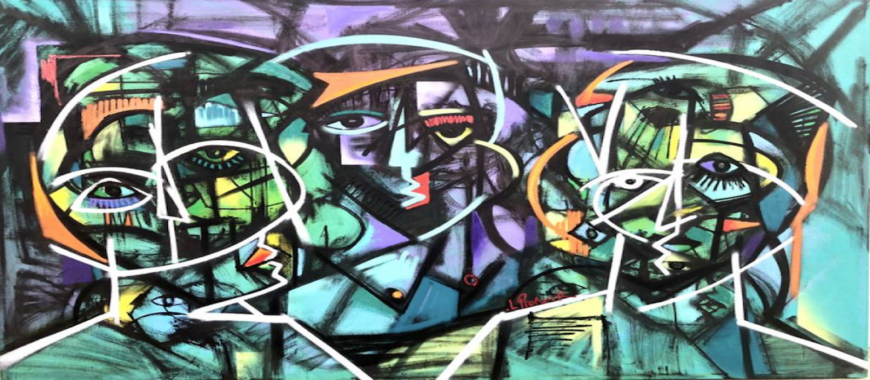The discussion by Laurent Proneur
Are you looking for something unique and different? How about the mind-bending art form of cubism? It’s a style that took the world by storm and shook the art industry.
What Is Cubism?
Cubist artworks are paintings made of geometric shapes and fragments that look like cubes. In Cubism, the artist takes a scene and objects and paints them from every angle on a flat surface. This style offers a unique, often odd, look at the world.
Aesthetics Chaotic by Marcos Inácio
How Cubism Started
Cubism started in 1907 when Pablo Picasso publicly displayed his first cubism painting, Les Demoiselles d’Avignon. It sparked outrage and criticism for its taboo subjects, jagged edges and out of proportion bodies.
The women in the painting were depicted in a way that seemingly invited the viewer into the space and stared at you with huge, misplaced eyes.
At the time, most people had a taste and appreciation for renaissance style art or realism. Respected artists painted pictures that turned 2D into 3D by drawing space and light. This new “cube-like” style did the reverse, turning 3D into 2D – which was off putting to many in the beginning.
Even Picasso, expecting disdain in response to his new work, didn’t reveal his painting for over a year, and reached out to French painter Georges Braque for a second opinion.
At first, he too was both appalled and stunned by the painting. But he also saw the brilliance in it. Their encounter sparked the beginning of a very intimate collaboration within this new, bizarre style of painting. The two artists saw each other in their studios every evening, critiquing each other’s work and pushing each other to try new things.
This went on until WWI began in 1914 and Braque was drafted to the French Army. They went their separate ways and never saw each other again – but they successfully made their mark on the world.
Kinds Of Cubism
It took almost 30 years for the Cubism movement to be accepted because it went against the grain of traditional methods like perspective, shading, and form, and the mainstream ideologies that art should imitate nature.
Cubist painters embraced the flat 2D surface of a canvas and presented a new reality with completely fragmented scenes and objects.
As more artists explored cubism, it developed different forms.
Analytical Cubism
This is the first phase of the movement that spanned from 1910 to 1912. Analytical Cubism blended foreground and background and showed objects from different perspectives.
It also prefered a monochromatic colour scheme because too much colour distracted the viewer from the artist’s intended purpose: to make you analyze.
Analytical Cubism Artists: Pablo Picasso, Georges Braque, Fernand Léger
Synthetic Cubism
Synthetic Cubism spanned from 1912 to 1914 and moved from the fragmented approach to a more simplified form that involved experimenting with collage using newspaper and printed patterns. Synthetic Cubism used a broader colour palette, less perspectives and more identifiable subjects.
Synthetic art pieces became like a riddle to be solved. You used all the shapes in the piece to figure out what the whole painting represents. In the collage by Picasso called Bottle of vieux marc glass, guitar and newspaper, you see the newspaper clipping, a glass and the shape of a guitare. What did Picasso paint? A scene at a cafe of course!
Synthetic Cubism artists: Pablo Picasso, Georges Braque, Juan Gris
Salon Cubism
The Salon Cubists were a group of avant-garde French artists who were inspired by Cubism but purposely took it in another direction. While Picasso and Braque experimented with Cubism in the sanctity of their studios, out of public view, Salon Cubists painted large scale artworks with bright colors and references in mathematics and vitalism.
Salon Cubists were the ones who made Cubism known as a movement to the world. They did this by introducing it in popular Paris Salons between 1910 and 1913, hence how they got their name.
Salon Cubist artists: Henri Le Fauconnier, Albert Gleizes, Jean Metzinger
Orphism
Unlike the monochromatic works of Picasso and Braque, Orphism emphasized colour, flow and energy. The Orphists wanted to create art that gave the same experience as music and often made color harmonies that copied musical scales and chords.
This is how Orphism got its name. The poet Guillaume Apollinaire saw the similarities between this style of art and the Greek god Orpheus, who was famous for his musical talents.
Orphism also managed to move away from traditional painting and showed itself in fashion and decor. In fact, one of the first works of this appeared as a patchwork blanket called Couverture de Berceau (1911) by Sonia Delaunay.
Orphism artists: Robert Delaunay, Sonia Delaunay, Vladimir Baranoff-Rossiné

Golden Night by Corne Akkers
—
Cubism offers new perspectives and interesting, eye-catching works. If this fascinating and groundbreaking style is something you’d like in your space, browse our curated gallery of one-of-a-kind modern artworks!





Comments (0)